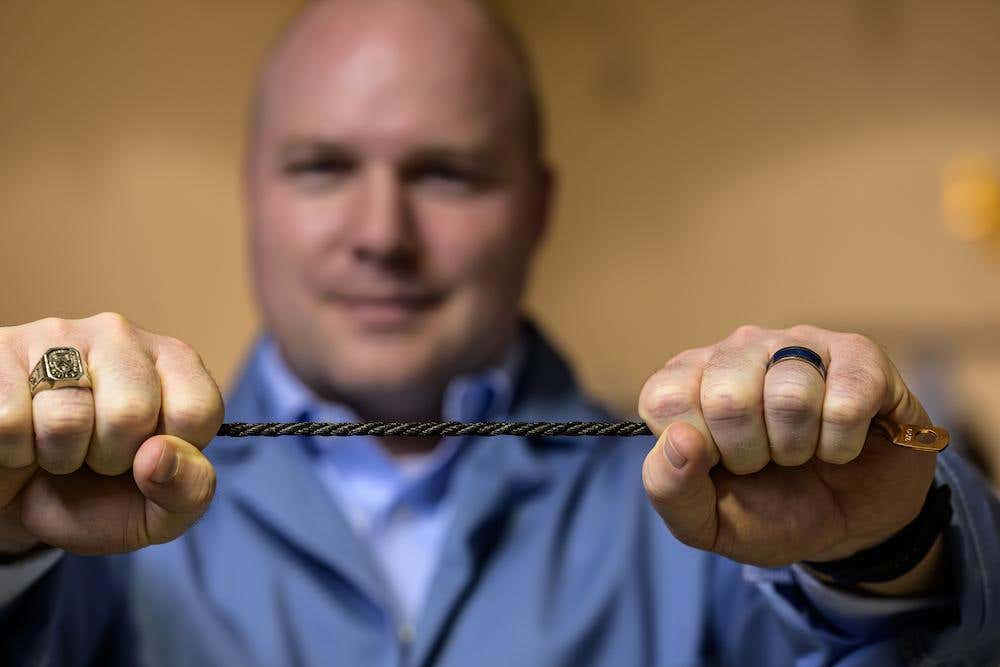Carbon nanotubes are paving the way to a greener future
One critical element that often flies under the radar but is indispensable for the clean energy transition is copper.

[Dec. 6, 2023: JD Shavit, The Brighter Side of News]
DexMat's fiber, held by CEO Bryan Hassin. (CREDIT: DexMat)
When addressing clean energy solutions, discussions often revolve around the shortage of lithium for electric vehicle batteries. However, one critical element that often flies under the radar but is indispensable for the clean energy transition is copper, aptly referred to as the "metal of electrification" by S&P Global. Copper plays a pivotal role in not only transmission wires but also in the scaling up of solar panels, wind turbines, and electric vehicles.
A Houston-based carbon nanotube startup, DexMat, is pioneering a revolutionary material called Galvorn. Galvorn is poised to disrupt various industries with its exceptional conductivity, superior strength compared to steel, and lighter weight than aluminum. In this article, we explore the groundbreaking potential of Galvorn and how it may catalyze significant advancements in clean energy and emissions reduction.
The Rise of Galvorn
DexMat, founded at Rice University and built upon the groundbreaking patents of Nobel Prize-winning chemist Rick Smalley and his collaborator Matteo Pasquali, is on a mission to revolutionize industries reliant on copper.
Copper is prized for its conductivity, but it’s also notoriously dense, lacks strength and flex tolerance, and is prone to corrosion. Galvorn’s conductivity of 10 MS/m today, combined with its lightweightness (1.5 g/cc), super strength (3.0 GPa), durability (> 1M flex life cycles), corrosion resistance, and biocompatibility make it a powerful candidate for existing and new applications that require conductivity.
Related Stories
Galvorn, the brainchild of DexMat, offers the conductivity of copper, is 30x stronger than steel, a lighter profile than aluminum and is carbon-negative at scale. With a density of 1.5 g /cc compared to aluminum at 2.7 g/cc, the potential for Galvorn to lighten the weight of traditional metal applications is boundless. This ambitious endeavor aims to address critical challenges in clean energy, automotive, aviation, and wearables sectors.
Already, DexMat has harnessed its innovative material for niche applications, such as electrothermal de-icing systems for plane wings, which eliminates the need for glycol-based chemicals. These applications are not only commercially viable but also environmentally friendly, aligning with the growing global push for sustainability.
The Potential Impact of Galvorn
One of the standout features of Galvorn is its potential to curb industrial carbon dioxide emissions on a massive scale. DexMat asserts that this groundbreaking material has the capability to displace three gigatons of carbon emissions annually. It achieves this not only by facilitating the adoption of clean energy sources but also by reducing the environmental footprint associated with the production of steel, aluminum, and Kevlar.
Galvorn is the result of a more than $20 million investment from the U.S. Air Force, NASA, and others. (CREDIT: DexMat)
Galvorn's versatility is a key factor in its far-reaching impact. It can be fabricated into various forms, including mesh, fiber, and film, each with unique applications. These include composite panels, conductive wires, power lines, motor windings, electromagnetic shieldings, batteries, and antennas. Such versatility positions Galvorn as a transformative material with the potential to revolutionize multiple industries.
Bryan Hassin, DexMat's newly appointed CEO, brings a wealth of experience from his previous role at Third Derivative, where he meticulously analyzed the business plans of numerous climate tech startups. He recognizes the unique potential of DexMat to fill a void in the market and make substantial contributions to the global sustainability agenda. Hassin's immediate focus is on scaling up Galvorn production while driving down costs through expanded manufacturing capacity.
Galvorn's production process is noteworthy for its sustainable approach. It involves the splitting of hydrocarbons, primarily sourced from the combustion of petroleum and natural gas. This process not only yields a highly conductive material but also acts as a form of carbon storage, aligning with the imperative need for carbon sequestration in the fight against climate change. The material's versatility, available in various forms, opens doors to a multitude of applications, ranging from construction materials to advanced electronics.
Shomik Dutta, managing partner at Overture Climate VC, emphasizes the dizzying potential impact of DexMat's Galvorn. It has the potential to usher in more efficient and lighter-weight vehicles and aircraft, extending their range and reducing fuel consumption. Enhanced electrical conductivity in batteries and supercapacitors can improve the performance of wind and solar energy storage systems.
Moreover, Galvorn can replace steel cores in utility transmission lines, offering a stronger, lighter, and more conductive alternative that enables the deployment of new transmission lines at a lower cost. In construction, incorporating Galvorn fibers into concrete and building materials can result in stronger and more durable structures with extended lifespans. The potential applications of Galvorn are diverse and extensive, promising far-reaching benefits across various sectors.
Beyond the scope of DexMat's innovation, the carbon nanotube industry itself holds immense promise. Market research by Fortune Business Insights predicts significant growth, with the sector anticipated to expand from $5.3 billion in 2021 to $10.5 billion by 2028. This projection underscores the increasing recognition of carbon nanotubes as a game-changing material with the potential to reshape numerous industries.
Galvorn carbon nanomaterial outperforms GHG-intense alternatives across a multitude of applications–and has the potential to be carbon-negative at scale. (CREDIT: DexMat)
One of the remarkable aspects of Galvorn is its utilization of methane as a primary feedstock. Considering that methane is a potent greenhouse gas, the incorporation of this gas into the production of Galvorn presents a unique opportunity to address emissions associated with carbon-intensive materials processes. Galvorn's ability to simultaneously reduce carbon emissions and improve the performance of various industries makes it a compelling solution in the battle against climate change.
As DexMat continues to scale up its production and explore new applications, the world may witness a paradigm shift in how we approach clean energy, transportation, construction, and more.
In an era where environmental sustainability is paramount, Galvorn emerges as a silent ally, offering a path to a brighter and cleaner future. It serves as a reminder that the most profound solutions often come from the unlikeliest of places, and in the case of Galvorn, it may very well be the key to unlocking a sustainable tomorrow.
For more green news stories check out our Green Impact section at The Brighter Side of News.
Note: Materials provided above by The Brighter Side of News. Content may be edited for style and length.
Like these kind of feel good stories? Get the Brighter Side of News' newsletter.



